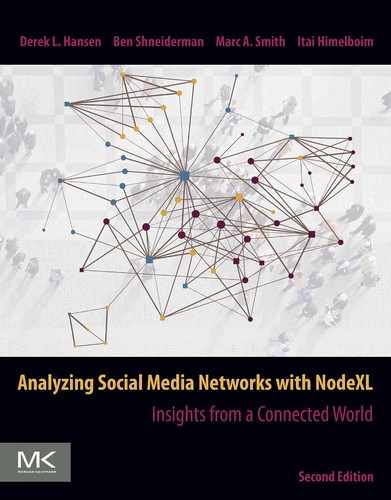Table of Contents
Part I: Getting started with analyzing social media networks
Chapter 1: Introduction to social media and social networks
1.3 The rise of enterprise social media applications
1.4 Individual contributions generate public wealth and risks
1.6 Applying social media to national priorities
Chapter 2: Social media: New technologies of collaboration
2.3 Social media design framework
Chapter 3: Social network analysis: Measuring, mapping, and modeling collections of connections
3.4 The network analysis research and practitioner landscape
3.6 Social networks in the era of abundant computation
3.7 The era of abundant social networks: From the desktop to your hand
3.8 Tools for network analysis
3.9 Node-link diagrams: Visually mapping social networks
3.10 Common network analysis questions applied to social media
Part II: NodeXL tutorial: Learning by doing
Chapter 4: Installation, orientation, and layout
4.2 Downloading and installing NodeXL
4.3 Getting started with NodeXL
4.4 Layout: Arranging vertices in the graph pane
4.5 Undirected and directed graph type
Chapter 5: Labeling and visual attributes
Chapter 6: Calculating and visualizing network metrics
6.4 Marvel cinematic universe network example
6.5 CSCW 2018 conference Twitter network example
Chapter 7: Grouping and filtering
7.2 U.S. Senate voting analysis
7.3 CSCW 2018 Twitter network analysis
7.4 Federal Communications Commission (FCC) lobbying coalition network
8.2 Creating the Twitter Gardasil HPV word pair network
8.5 Visualizing computing dissertation and thesis connections
Part III: Social media network analysis case studies
Chapter 9: Email: The lifeblood of modern communication
9.2 History and definition of email
9.4 What questions can be answered by analyzing email networks?
9.6 Cleaning email data in NodeXL
9.7 Analyzing personal email networks
9.8 Creating a living org-chart with an organizational email network
9.9 Historical and legal analysis of Enron email
Chapter 10: Thread networks: Mapping message boards and email lists
10.2 Definition and history of threaded conversation
10.3 What questions can be asked
10.4 Threaded conversation networks
10.5 Identifying important people and social roles in the CSS-D Q&A reply network
10.6 Understanding groups at Ravelry
Chapter 11: Twitter: Information flows, influencers, and organic communities
11.2 Defining your topic-networks: Formulating a social media monitoring query
11.8 Share your work on the NodeXL graph gallery
Chapter 12: Facebook: Public pages and inter-organizational networks
12.1 Introduction to Facebook: The social graph of 2 billion people
12.3 Organizational networks: Fan pages
Chapter 13: YouTube: Exploring video networks
13.5 Hubs, groups, and layers: What questions can social network analysis of YouTube answer?
13.6 Importing YouTube data into NodeXL
13.7 Preparing YouTube network data
13.8 Analyzing YouTube networks
Chapter 14: Wiki networks: Connections of culture and collaboration
14.2 Key features of wiki systems
14.3 Wiki networks from edit activity
14.4 Using the NodeXL MediaWiki page network importer to access Wikipedia networks
14.5 Understanding topics through page-to-page connections
14.6 Analyzing the structure of discussion page interaction
